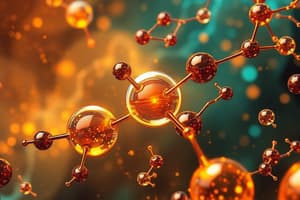Podcast
Questions and Answers
What type of isomerism does butane and isobutane exemplify?
What type of isomerism does butane and isobutane exemplify?
- Functional isomerism
- Geometric isomerism (correct)
- Structural isomerism
- Enantiomerism
Which statement accurately describes enantiomers?
Which statement accurately describes enantiomers?
- They are identical in bonding but differ in spatial arrangement.
- They differ in the covalent arrangement of atoms.
- They are non-superimposable mirror images. (correct)
- They are superimposable on each other.
How are cis and trans isomers differentiated?
How are cis and trans isomers differentiated?
- By the number of carbon atoms they contain.
- By the spatial arrangement of atoms. (correct)
- By the presence of double bonds only.
- By their covalent bond types.
Which of these pairs represents structural isomers?
Which of these pairs represents structural isomers?
Which is true regarding geometric isomers?
Which is true regarding geometric isomers?
What characteristic allows carbon to form a diverse range of compounds?
What characteristic allows carbon to form a diverse range of compounds?
What is the structural feature of hydrocarbons?
What is the structural feature of hydrocarbons?
Which of the following statements about isomers is true?
Which of the following statements about isomers is true?
What type of bond can carbon form between two of its atoms?
What type of bond can carbon form between two of its atoms?
Which statement accurately describes a tetrahedral shape in relation to carbon?
Which statement accurately describes a tetrahedral shape in relation to carbon?
Flashcards are hidden until you start studying
Study Notes
Carbon
- Central component of organic matter
- Has 4 valence electrons
- Forms 4 covalent bonds
- Carbon-to-carbon bonds are strong, single, double, or triple
Hydrocarbons
- Only contain hydrogen and carbon
Isomers
- Same molecular formula, different structural formula
- Have different physical and chemical properties
- Cells can differentiate between them
Structural Isomers
- Differ in covalent arrangements of atoms
Geometric Isomers
- Same covalent bonds, different spatial arrangement
- Cis: same side
- Trans: opposite sides
Enantiomers
- Mirror images
- Non-superimposable
Organic Compounds
- Contain carbon and hydrogen
- Carbohydrates
- Lipids
- Proteins
- Nucleic acids
Inorganic Compounds
- Do not contain carbon and hydrogen simultaneously
- CO₂
- CaCO₃
Association of Carbon with Other Elements
- Association with oxygen, nitrogen, and phosphorus
- Alters properties
Geometric Isomers
- Cis: groups on the same side of the double bond
- Trans: groups on opposite sides of the double bond
Enantiomers
- Non-superimposable mirror images
Functional Groups and Properties
- Influence an organic molecule's properties
- Hydroxyl
- Carboxyl
- Amino
- Phosphate
- Sulfhydryl
Variety Among Molecules
- Variety influenced by combinations of atoms and functional groups
Hydrocarbons
- Non-polar and hydrophobic
- Insoluble in water
Addition of Hydroxyl Groups
- Polar and hydrophilic
- Soluble in water
Addition of Carbonyl Group
- Aldehyde: carbonyl group at the end of the molecule
- Ketone: carbonyl group in the middle of the molecule
Addition of Carboxyl Group
- Weakly acidic, polar, hydrophilic
- Examples include amino acids
Addition of Amino Group
- Creates a basic group
- Weakly basic
Phosphate Groups
- Non-ionized: R - O - P - OH
- Ionized: R - O - P = O
- Weakly acidic
- Example: Phosphoric ester
Sulfhydryl Groups
- Non-ionized: R - S - H
- Help stabilize proteins
- Example: Cysteine
Biological Molecules
- Many are polymers
- Macromolecules are large
- Polymers make up macromolecules
| Monomer | Polymer |
|---|---|
| Amino acid | protein |
| Monosaccharide | Polysaccharide, Cellulose, Starch, Glycogen |
| Nucleotide | Nucleic acid (RNA and DNA) |
| Fatty acid | Triglyceride |
Polymerization
- Monomers combine to form polymers
Studying That Suits You
Use AI to generate personalized quizzes and flashcards to suit your learning preferences.



